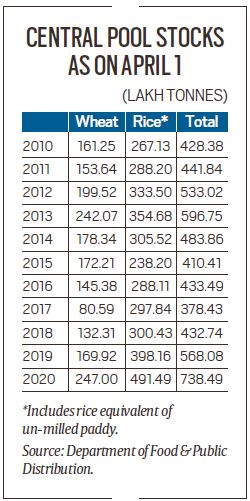 The previous record of wheat stocks for this date was 24.21 mt in 2013. (Representational)
The previous record of wheat stocks for this date was 24.21 mt in 2013. (Representational)
Foodgrain stocks in the Central pool stood at 73.85 million tonnes (mt) as on April 1, the highest ever for this date and three-and-a-half times the minimum operational-cum-strategic reserve requirement of 21.04 mt.
The 73.85 mt figure includes 24.70 mt of wheat and 32.24 mt of rice. In addition, the Food Corporation of India (FCI) and state government agencies were holding 25.24 mt of un-milled paddy, whose rice equivalent, at an out-turn ratio of 67 per cent, worked out to 16.91 mt. Out-turn is the share of rice extracted from harvested paddy grains after removal of outer husk and inner bran layers.
Follow coronavirus news LIVE updates here
The wheat stocks of 24.7 mt were 3.3 times the necessary level of 7.46 mt for April 1, when the procurement season for the new crop also starts. The previous record for this date was 24.21 mt in 2013 (see table). Rice stocks (inclusive of the milled paddy equivalent) were also at an all-time-high of 49.15 mt and 3.6 times the normative minimum of 13.58 mt for April 1.
The build-up of stocks to such high levels is mainly a result of governmental procurement of grain exceeding offtake from the Central pool. In 2019-20 (April-March) alone, total procurement amounted to 80.64 mt, comprising 46.51 mt rice and 34.13 mt wheat. As against this, the aggregate offtake was just over 62 mt.

That included 52.85 mt under the National Food Security Act (NFSA), 3.77 mt under midday meals and other welfare schemes, and 5.25 mt of open market sales through e-auctions.
The Pradhan Mantri Garib Kalyan Yojana (PMGKY) relief package, announced on March 27 to alleviate the distress of people most affected by the nationwide lockdown, might help whittle down some of the excess foodgrain stocks.
The NFSA, currently, entitles three-fourths of all rural and half of all urban households to 5 kg of wheat or rice per person per month at Rs 2/kg and Rs 3/kg, respectively. Under the new package, an extra 5 kg of wheat/rice is being given per person per month, free of cost, for a three-month period from April to June 2020. An additional 12.14 mt of wheat and rice has been allocated for this purpose.
The government was, until recently, not aggressively disposing of stocks from public warehouses, largely for financial and accounting reasons. The FCI’s “economic cost” of procuring and distributing grain was estimated at Rs 26.80 per kg for wheat and Rs 37.48 per kg for rice in 2019-20. But concerns over issuing grains at low cost, or even free, have had to take a backseat for two reasons.
The first has, of course, been the prospect of large-scale hunger from a sudden collapse of workdays and incomes following the lockdown. The second is a bumper wheat crop that farmers are now harvesting and bringing to the mandis.
The total storage capacity available with FCI and state agencies has been assessed at 75.85 mt as on December 31, 2019. That includes 62.64 mt of covered godown space, with the remaining 13.20 mt being open storage in cover-and-plinth structures. With procurement of the new crop taking off, the challenge of stocking is expected to go up in the coming weeks. The only “relief” may come from PMGKY.
Apart from economic cost, FCI also incurs interest and storage expenses in holding excess stocks in its godowns. That “carrying cost”, estimated at Rs 5.61 per kg in 2019-20, will be saved even when grain is given out free.